Interviewsand Articles
Three Hours of Free Time in Berkeley
by Richard Whittaker, May 17, 2022

I dropped my wife off at SF’s International Airport and headed home for two weeks of life on my own. While she was in Macedonia visiting medieval Greek Orthodox churches to study icons, I’d try to find some adventures of my own. I’d already thought of one. It involved a chore I’d been putting off for weeks—taking our car to the dealer for routine maintenance. The very next day on a chilly overcast morning in downtown Berkeley, I found myself standing at a counter in the dealer’s service bay. It was 8:30 a.m. I noticed the man writing up the order was left-handed. “A lefty,” I said in a cheery tone.
“Left-handed people are the creative ones,” he said.
“Are you artistic?” I asked, warming up to the moment.
He slumped a little. “I used to be, but I had to get a job, you know.”
Here was someone who needed some encouragement. “You never lose that, you know! It’s still in there,” I said on the upbeat.
“I used to draw and paint a little,” he said, looking up at me. “Sign here.”
“One of these days, you might find all that again,” I added, smiling. “I’m a lefty, too. I know what you’re talking about!”
I handed the signed order to him and he told me the car would be ready in two hours, but hedged a bit. Adding an hour to his estimate, I walked out with nothing but free time ahead.
As often as I’d been in Berkeley, I’d never been there without a destination or simple purpose. This time, as I headed into the cool, gray morning, I would wander as the spirit moved me. Lacking a destination and without my car, the city stretching out before me came to life in a new way.
Out on Channing, the first question was, left or right? I turned right, walked up to Shattuck and waited for the light. Crossing that typically most congested of Berkeley's streets and continuing on Channing, I hadn’t gone half a block before a building caught my eye that I’d never noticed. “Berkeley Buddhist Temple” I read on its welcoming signage, and in smaller print, “Rev. Kiyonobu Kuwahara.” And in still smaller print, “Nembutsu.” Hmm. Later I learned that nembutsu is a core practice in Pure Land Buddhism and means “mindfulness of Buddha.” But I knew nothing of that in the moment. Instead, I paused for a couple of minutes to take in the adjacent buildings and wondered how many Buddhist places there were in Berkeley. Was it was connected with the Berkeley Buddhist Monastery and Reverend Heng Sure? Did all the Buddhist groups in Berkeley know of each other?
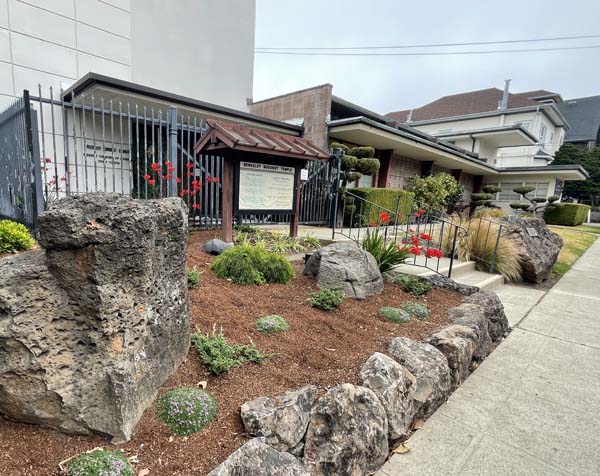
Letting these thoughts go, I continued up Channing to Fulton where I turned left. A young woman was heading toward me keeping her eyes to herself, and we passed in silence - always a quiet drama there: will it be a smile, a greeting, a remark, my silo preserved? Nearing Durant, an older concrete building caught my attention and I stopped to look at it. From its art deco detailing I guessed it was built in the 1920s or 30s. Making my way around the corner and down to the building’s entrance, I read “Jodo Shinshu Center of the Buddhist Churches of America” And in smaller print, “The Institute of Buddhist Studies” and “Ryukoko University Berkeley Center.” Wow. Who knew?
I stood there feeling how much I'd already seen in just a few minutes of walking.
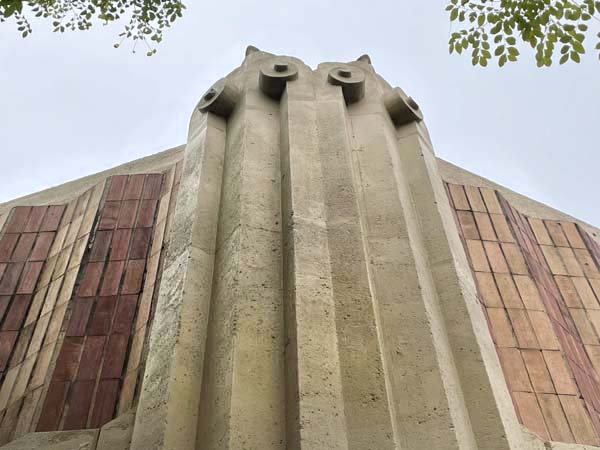
No one was to be seen, but maybe the place was open, I thought, and stepped up to try the main entrance. Locked. So I walked a little further to the building’s large parking area where I could see a second entrance. Just as I headed toward it, a security guard appeared from the building coming my way. “Can I help you?” he asked.
“Maybe,” I said, taking him up on his offer. “Can you tell me anything about this place? Like is it open?”
He was happy to tell me about the place, and we were soon conversing. At a certain point, I asked him, “Are you a Buddhist?”
“No.”
“You must get to meet a lot of Buddhists.”
“Oh, yes!” he said with a big smile. “Lots of them!”
“Is any of that Buddhism rubbing off on you?” I asked on an impulse.
He laughed. “I think so.”
“Do you mind if I ask your name.”
Straightening up, he said, “James Simon.”
Funny how so much can be conveyed without words. The dignity made visible only added to my feeling of relationship that had developed in such a short time.
“Things have changed so much in Berkeley,” he said.
“Like all the new construction—that building across the street, for instance?”
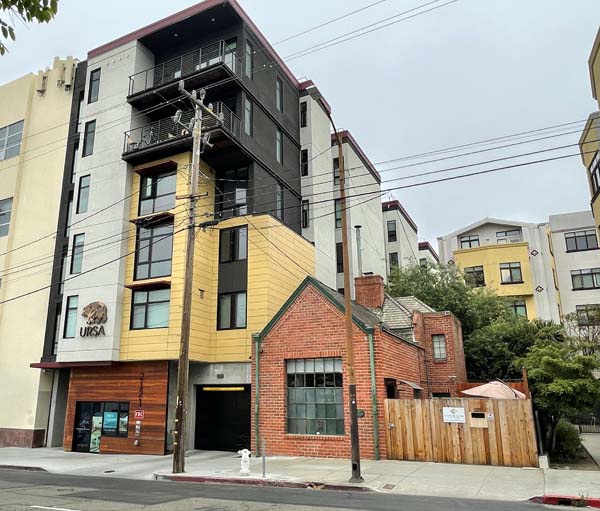
He agreed, and I asked, “Are you an old-timer in Berkeley?”
“Born and bred,” he said with obvious pride. “Like this [gesturing to the parking lot] used to be Reggie Jackson’s Buick dealership!”
Gosh. Now I’d learned something else I never would have known. This revelation was followed by animated conversation about the Oakland “A”s.
"And Reggie Jackson seemed so personable," I said. "Did you ever meet him?”
Simon had met Reggie, and yes, he was really that way. He’d also met a lot of the Buddhists who visit the Jodo Shin-Shu Center from other countries. What had started out as an inquiry from a security guard had become a warm exchange, a small joy, really—two strangers meeting across a cultural divide that had evaporated very quickly.
We parted in good spirits and I headed back up Durant, turned left on Fulton and continued toward University Ave. where I soon arrived at the edge of a major construction project complete with heavy machinery, men in hard hats, chain link fences and a question about which direction to take to get through it all.
Spotting a through-line, but not being sure if it was open to pedestrians, I headed right across the street to find out. Two construction men stopped me.
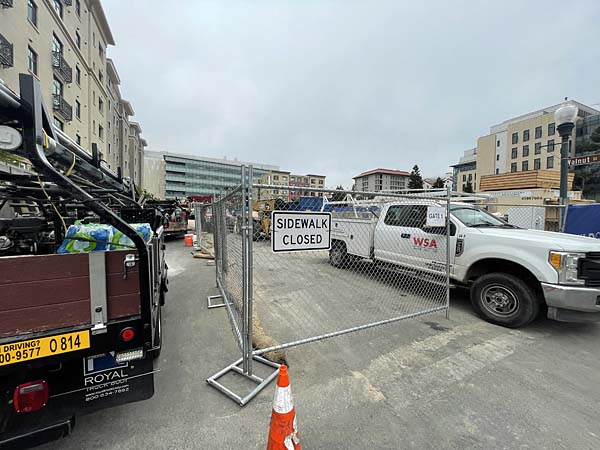
Really? I pointed out how open the passage was and took a shot at seeing if I could persuade them to make an exception. No. Rules were rules. Just then another construction fellow who had seen what was developing came our way and waved me through. Thanking him, I continued along the west side of this project when I came to another worker. “What are you guys building here?” I asked him.
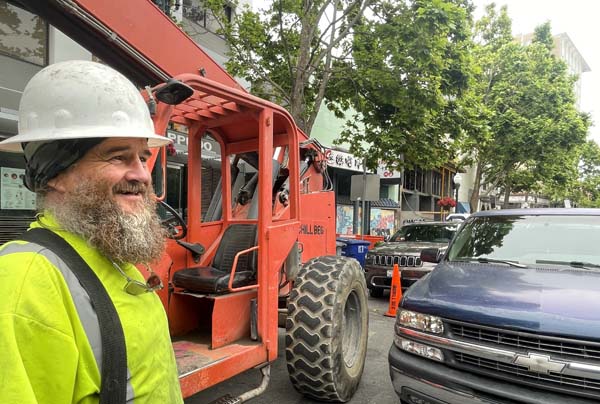
What followed was a fairly comprehensive description: the building would have 13 stories of housing specifically for students transferring to UCB from community colleges. He even went into the amenities that would be part of this new edifice. As he was telling me all this, a pedestrian who’d come along in my wake stopped and began filling me in on some other details—all this in a no man’s land of blocked streets, dust, heavy construction and putatively serious dangers to life and limb.
“How do you know about this project?” I asked my new pedestrian companion.
“I read the papers,” he said. Ha.
By that point, I’d walked four blocks. And by then I wasn’t far from University Avenue. But suddenly I wasn’t sure I wanted to cross it and head into North Berkeley. That’s when I remembered a thought from a few days earlier about how I might spend my time waiting to pick up my car. I could call my friend Haricharan Das. And so I pulled out my cell phone. Hari was home. “How about meeting at the Cheese Board,” he suggested.
“I’m walking and think I can be there in about 15 minutes,” I said, and headed north.
I hadn’t gone far though, before I had to stop and go down an alley that looked interesting. The backside of an older two-story building made me stop. It was fitted with an outsized array of shining ductwork running up its back wall and across its roof. The contrast between the old building and this industrial grade installation made me wonder what was going on inside it. And on just the far side of this old building a new one towered above it in stark architectural contrast.
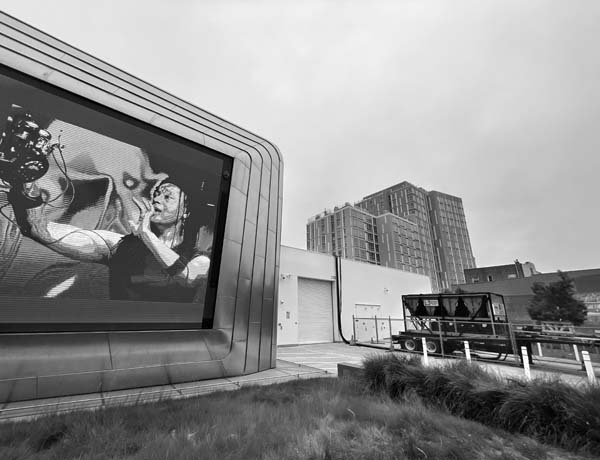
[ photo: Berkeley Art Museum/Pacifi Film Archive on Fulton Street]
Moving on, I began to notice feelings I’d never had as I walked past shops. The smaller ones, especially, touched me. Each spoke of someone throwing in on life, taking the chance of starting a business—a living drama, invisible, but present just behind the facades of each passing storefront. Life was right there - all the time, I realized. What kept me from being present to it?
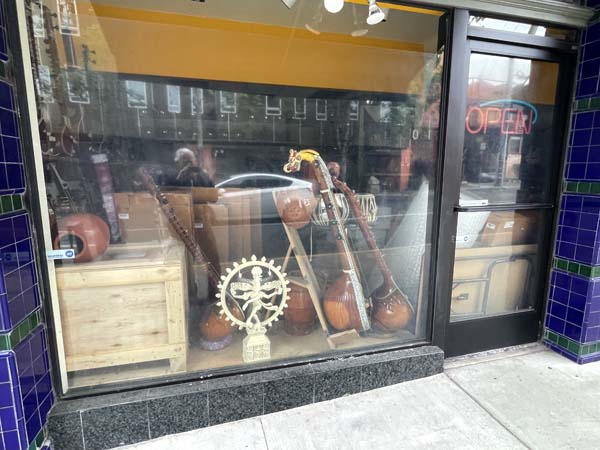
I knew Hari wouldn’t mind if my estimate of fifteen minutes stretched out to twenty-five. Far from getting impatient, he’d have his own ways of making use of the time.
Let me tell you how I met Haricharan.
Some years ago I needed some painting done on my house. His name showed up on a list of painters well recommended. The memory of what happened when he showed up at my front door is still vivid. A man, tall and with a shaved head, smiled and I invited him in.
“Wow. You have a lot of art in here!” he exclaimed.
No one else had ever reacted so immediately to the paintings, photos, and sculptures my wife and I had made and accumulated over the years. Stepping into the living room, he looking from piece to piece as I told him a little about each one. “You know, art is always connected with God,” he said.
Who was this man? I thought.
Maybe a half hour passed before I finally took him to look at the peeling paint on our window sashes and a week later, Haricharan Das was at work painting. Late in the afternoon each day, I’d check his progress and we’d talk. He’d grown up in Long Island, but had spent a lot of time in India. He painted in order to have money to travel with his Tibetan wife to India who, even as a child had been ministering to recluse monks and nuns. Hari had met a guru, Sant Keshavadas, in remarkable circumstances and now was carrying on his work. He’d been conducting yoga and meditation classes at his home in Berkeley on Sundays. Each afternoon, I’d talk with this man in his painter’s hat and clothes and one exotic story unfolded after another. I could hardly believe such an unlikely circumstance. Was it just luck? After a week of this, I asked if he be open to an interview.
More than ten years had passed since he’d appeared at my door. We’d kept in touch, but I hadn’t seen him in a while and, as I was making my way to our rendezvous, I was looking forward to seeing him again. Walking north along Shattuck, I spotted him ahead standing in front of a café. “The Cheese Board is closed,” he said. “What do you think about this place?”
We sat at a little table on the sidewalk with our cappuccinos catching up with each other. I knew that he used to meditate eight hours a day. Eight hours. “It was easy,” he said. A few years later, I’d asked him how his meditation was going and he told me an injury had made the sitting posture impossible, so he’d found new practices. Remembering that, I asked him what his practices were now. As he was telling me, I soon wished he was being recorded. Would that be okay? It was, and we pick up there…
Haricharan: Each morning, I pray for the first five people that come to mind. And it’s really funny—sometimes people you haven’t thought of in thirty, forty years pop up for no reason at all. With the habit of praying every morning, I guess the subconscious reaches out and finds who needs a prayer [laughs]. Sometimes it’s just local friends, or sometimes it’s childhood friends, or sometimes it’s an incidental person I met on a train platform who shows up in my mind [laughs]. So I say a prayer for them.
Then another secondary practice is that I’ve learned to attach walking to the names of God. So when I take one step, I say ‘Rama.’ When I take the second step, I say ‘Krishna.’ So as I’m walking I’m saying ‘Rama, Krishna, Rama, Krishna.’
Richard: When you’re doing this, do you try to be present with the sensation of your body, too?
Haricharan: No. It’s just the awareness of the sanctity of God. That’s all I try to do. And now it’s become a habit; it just quietly arises—like when I walked down here to the café, it’s ‘Rama, Krishna, Rama, Krishna.’ Now it’s a habit. So that’s another secondary practice.
Richard: How does this practice affect your state? I mean, before you came down this morning, for instance?
Haricharan: Well before, your mind is drifting with the ten thousand events and thoughts. But now when I’m walking with the “Rama, Krishna, Rama, Krishna,” it’s sort of like having an umbrella. [laughs] My mind is never far from sanctity, see? It’s sort of like walking with Jesus or walking with Buddha—or maybe like walking with your mother. You’re always aware of the loving nature of your mother. Even if you’re not talking, you're in relationship.
So another secondary practice is that I’ve trained myself to pray for anybody I’ve been in contact with during the day. Sometimes I’ll pray right in the moment, like with that gentleman [begging] on the side who you were chatting with. Or sometimes I’ll gather my thoughts and pray at noon. Or when I’m in bed at night.
We meet many incidental people—a clerk in the market—we do our business and go. But we don’t recognize their humanity at all. We don’t even remember whether it was a male or female clerk who gave us our goods three minutes ago. I thought that was not right. So now I keep a mental catalog of every single person I meet during the course of the day and make it a point of praying for the welfare of that person. What I’ve found is that it keeps me in contact with my humanity—and the humanity of everybody else. We don’t think, “Oh, does that clerk have children? Does she have a family? Or, how is her health? How is her mother’s health?
Now I think about these people as whole people. It first started with any person I met and had an interaction with. That went on for a couple of years. Now I have a prayer for anyone I think about. At the very least, at the end of the day I go through the catalog of each soul I’ve met and pray for their welfare.
Richard: That’s beautiful.
Haricharan: [laughs] You know an old guy like me needs something to do to keep out of trouble. I think I was born with mischief.
Richard: I missed the things you said earlier, like the five-stone exercise, and then the seven-stone exercise – and you said that our mind is always touching everything although we’re usually not conscious of that, right?
Haricharan: That’s correct. Consciously and unconsciously we’re always massaging every thought, every feeling, every stimulus we come across. But most of the time, it has no purpose or value.
Richard: Most of the time we’re caught up in our anxieties and frustrations…
Haricharan: And fantasies..
Richard: We’re caught up in all that and it just churns along.
Haricharan: Exactly. Exactly. And these five-stone and twelve-stone practices get us into the habit of connecting with sanctity on a persistent level until that becomes a substratum of our life of which the rest of our life feeds on—or we inoculate the rest our life with the remembrance of sanctity.
Richard: That’s beautiful. We inoculate ourself if we can establish a practice of connecting with something higher.
Haricharan: Exactly. Which goes to the root, or purpose of our life—or the deepest identity of our lives. We’re identified with our fears and frustrations, but is that why we were born? Is that really the kernal of our true existence? No. No. Read the great saints and masters.
Richard: So lot of things seem to be going downhill today in our culture. There’s a loss of trust in our institutions and feelings of despair, and it seems the social fabric is getting thinner. Earlier you were talking about how not to get caught up in it. But it’s not as though we don't feel the tragedy of it.
Haricharan: No. We acknowledge it.
Richard: So the question is, what can we bring? What kind of energy?
Haricharan: We have to try to generate a persistent sanctity, which will go to the root of things in life with an uplifting effect as opposed to emotionally and psychologically being on the carousel of ups and downs with the tragedies and joys of life. There has to be some persistent note of sanctity, and that’s what the yogi is generating—a persistent note of sanctity in this mad world.
Richard: Can that same thing be said in any other ways?
Haricharan: There are many ways of understanding that. The yogi, as a being, has to learn to connect to a deeper reality that is constantly present and stable—you can say your sacred self as opposed to your psychological self. Your psychological self is constantly in flux. Your sacred self is one, persistent reality. It’s stable. The rest of the world is not stable. So we have to learn to be in communion with that sanctified stability and then have that generate, through our actions in life—whether it’s a smile, a kind word or a noble project—from micro to macro, the sacred self has to be the governor of our manifestations in the world.
Here I stopped recording. Soon, I’d make my way back to the dealership and pick up my car. My wife would still be on her own adventure. Well over two hours had passed.
We left the cafe and walked back to Hari's home a few blocks away, stopping frequently to appreciate something in a garden or the look of a house. The sun had broken through the overcast sky. At certain moment, I realized as we chatted and laughed, how present I was walking along—present with every step.
About the Author
Richard Whittaker is the founding editor of works & conversations and West Coast editor of Parabola magazine.
SUBSCRIBE NOW
TO OUR MONTHLY NEWSLETTER









Share Your Comments and Reflections on this Conversation:
On Nov 9, 2022 rahul wrote:
Beautifully written! More beautiful is to have the good karma to have a friend like Haricharan. Hope many people walk with sanctity in every step and have a prayer for every soul they encounter?On Aug 21, 2022 maja wrote:
Thank you, Richard for your presence and for the persistent note of sanctity in this mad world that you bring to life. So grateful! We were together in a breakout room once, but it was over too quickly. Wishing you well!On Aug 2, 2022 Helen Gennari wrote:
Richard, thank you for the gift of your story. I love the way you simply made yourself available to the Moment and let your journey evolve, with the outcome of time with your friend Hari that, obviously became a gift for both of you.On Jul 6, 2022 Ruth Block wrote:
Thank you Richard, and for interviewing and bringing to us your relatable friend Hari. I'd missed your unique voice for a while that is so easy to relate to and bring home to heart.On Jul 5, 2022 Anne Veh wrote:
You astound me in your sensitivity and patience, to wait for other souls to reveal what is beneath, the stories we hold inside. You have an uncanny gift of presence to bring these stories out and to celebrate them in the perfect context. You are a treasure!On Jul 2, 2022 Sr Marilyn Lacey wrote:
Richard, your awareness and your reflections are always fascinating. Makes me realize how fast I am speeding thru life. Thx for the slow moments!On Jul 1, 2022 abbe rolnick wrote:
Richard--observational walking. My last newsletter was very similar. I wish I could send it to you.On Jul 1, 2022 Claudette wrote:
Beautifully written peace of mindfulness ☺️ Thank you for being a bright spot on my day! 🙏On Jul 1, 2022 Brinda wrote:
A beautiful meditative walk with you to start the day. Thank you for this deeply insightful piece. Deep bows of gratitude.On Jul 1, 2022 Rajesh S wrote:
I walked with you, Richard, every step, saying "Oh my" and then near the end realized i should have been saying "Om Namo Shivaya" or something like that.On Jul 1, 2022 Jo-Neal Graves wrote:
What a lovely article. I was born and raised in the East Bay. This reminded me what a magical place it is….interesting characters abound. Thank you!On Jul 1, 2022 Jennifer wrote:
A beautifully written article and perfect for an early morning meditation. It shaped and provided a lovely foundation for my day.On Jul 1, 2022 Nalini wrote:
This was a beautiful article. We w drove to Berkeley for 6 years while our two kids attended college. All the street names are so familiar and create nostalgic memories. The article is very very heartwarming. Thank you so much. Would really like to get to know the author. Very well written articleOn Jul 1, 2022 Mish wrote:
A wonderful meeting of minds & hearts there. Brought me peace to take this all in. Thank you 🙏On Jul 1, 2022 Jayant Ghate wrote:
Totally engrossing and reminds one of similar experiences in own life!